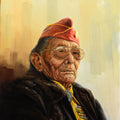Remembering Ed Mell
By Chadd Scott on
Contemporary Western art lost a giant last week with the passing of Ed Mell (1942–2024) on February 21 at age 81. No adjective, however, not giant or legend or icon or titan, seems adequate in explaining his influence on the genre.
Ed Mell was contemporary Western art.
His dramatic, angular, reduced landscapes – often featuring his native Arizona – helped show how non-representational painting could simultaneously honor the genre’s traditions and engage with Modern art trends – Cubism, Minimalism, Art Deco. He was Western and contemporary when many galleries, museums and collectors thought an artist had to choose one or the other.

Diorama of ‘Riders of the Purple Sage’ opera set, designed by Ed Mell. | Photos Courtesy Mark Sublette
I came to art and art writing late. In my 40s. Ed Mell was the first Western artist whose work I could identify without reading the wall label. A unique vision for landscape painting. One regularly, let’s say “borrowed from” – to be kind – by other artists today.
He represents something of an anchor for me, bedrock, the artist and artwork upon which my love for the genre has been built.

Ed Mell in his Studio. | Photos Courtesy Mark Sublette
I’m not the only one to have that opinion.
“(Mell’s) work and career has had a big influence on what I do,” contemporary Western art superstar Logan Maxwell Hagege posted to his Instagram account on January 30, 2024. “Ed has created his own world and vision of the Southwest and has opened the door for many artists who paint a more ‘modernist’ version of the West.”
Mell had been sick for a long time; Hagege’s post feels like an early eulogy for his friend.
"A big loss to the art world,” John Moyers, a contemporary of Mell’s in the Western art genre, told me. “He was a pioneer. There's a lot of young artists influenced by Ed's work, plus, he was a super guy, a real gentleman. We'll all miss him."
I only spoke to Ed Mell once, back in early 2020 – before the pandemic. I was writing a story about his receiving the Lifetime Achievement Award from The Desert Caballeros Western Museum in Wickenburg, AZ.
“Mell paints mountains in the image of the Chrysler Building,” I wrote at the time. “’Mad Men’ meets Maynard Dixon.”

New works show at Mark Sublette Medicine Man Gallery c. 2018 | Photos Courtesy Mark Sublette
Mell left Arizona for art school in Los Angeles and a successful career as an art director at a prestigious New York advertising agency. He would go on to lead his own illustration studio there, but he missed the desert. The concrete and steel canyons along Broadway can’t compare to the real thing. Mell was born, and died, in Phoenix.
“I think I bring something new to the to the Western landscape and I try to treat it with reverence and impact it with power and in many cases the drama that you really see out here,” Mell told me about his unique painting style. “Everybody has a dream of the West and I think what I'm doing plays a part in that.”
Mell never stopped dreaming of the West himself.
“For more than 50 years, Mell helped create a quintessential view of the rugged beauty of the Sonoran Desert and the American West through iconic paintings, prints, and sculptures,” the Phoenix Art Museum posted to its Instagram account following the news of Mell’s passing. “His paintings defied space, geologies, and light to create unique microcosms of their own, landscapes both in and out of time that lean toward emotion and impact rather than representational beauty.”
Medicine Man Gallery founder and owner Mark Sublette represented Mell’s artwork for over 25 years, becoming close friends in the process.
“The sunsets won’t be as bright tonight knowing he is no longer with us,” Sublette shared on his @medicinemangallery Instagram account after Mell’s passing. “We are fortunate to have his beautiful paintings to remind us of his light.”
This website along with Medicine Man Gallery’s YouTube channel and Sublette’s “Art Dealer Diaries” podcast offer a wealth of resources for learning more about Mell.



